Tap Water Quality and Habits of Its Use: A Comparative Analysis in Poland and Ukraine
Abstract
:1. Introduction
- Do habits related to the use of tap water differ between Poland and Ukraine?
- Does the evaluation of individual parameters of tap water differ between Polish and Ukrainian consumers in any period?
- Are any parameters of tap water similarly rated among Polish and Ukrainian consumers in particular seasons of the year?
- What are the evaluations of various parameters of tap water supplied in Poland and Ukraine for all seasons of the year?
2. Literature Review
3. Materials and Methods
- Multivariate correspondence analysis (MCA), to find out the average profile of the recipient and graphically present the co-occurring clusters of segmentation criteria and profile variables. A multivariate correspondence analysis (MCA) was performed to compare the two countries. There was no need to perform this analysis separately for each country. The record of the observed counts of characteristic categories was made using Burt’s matrix (table), which is a product of the form ZTZ, where Z is the code matrix and ZT is the transposed Z matrix [60]. In order to analyze the profiles, the distance between them was calculated using a weighted Euclidean metric [60]. In order to represent the analyzed set of points in a three-dimensional space with full- or nearly full-row diversity information, the method of matrix decomposition by singular values [60] was used.
- Multidimensional cluster analysis, to extract homogeneous subsets of objects (i.e., factor subgroups), which are more “similar” to objects from a given cluster in comparison to objects from other clusters. Within this analysis, the objects (parameters) were clustered in two ways: hierarchical agglomeration method and non-hierarchical clustering by k-means method. In the case of the former method, Euclidean distance was used as the distance function [60]. On the other hand, Ward’s method was adopted as the principle of binding clusters together. This method aims to minimize the sum of squares of deviations within clusters. At each stage, from among all possible pairs of clusters, Ward’s method selects the pair which, as a result of merging, gives a cluster with the minimum variation. The measure of this variation with respect to the mean value is the ESS expression (error sum from squares), also called error sum of squares [60].
- PROFIT analysis, to assess the similarity of the studied objects in terms of selected characteristics and to develop a graphical presentation of the results of grouping objects and their relationships to the studied features in the form of a perception map [61].
4. Results and Discussion
4.1. Study of the Relationship between the State and the Period of Consumption of the Largest Amount of Tap Water Supplied and the Use of Tap Water Directly for Drinking without Boiling
4.2. Examination of the Relationship between the Country and the Period of Consumption of the Largest Quantity of Tap Water Supplied and the Use of an Additional Tap Water Filtration and/or Treatment Device
4.3. Comparative Analysis of the Evaluation of Selected Parameters of Tap Water Supplied in Poland and Ukraine
4.4. Identification of Parameters of Tap Water Supplied in Poland and Ukraine Evaluated Significantly Similarly during Individual Periods of the Year
- Agglomeration method, used for visual identification of the number of parameter groups (clusters) similar to each other in terms of ratings (distances between clusters were obtained using Ward’s method), and;
- Non-hierarchical factor-clustering method, so called k-means clustering, used to separate clusters and their elements based on the number of clusters identified by the previous method.
4.5. Model of Evaluations of Parameters of Tap Water Supplied in Poland and Ukraine during Individual Seasons of the Year
- Taste of tap water supplied in Poland (Taste (PL)),
- Taste of tap water supplied in Ukraine (Taste (UA)),
- Odor of tap water supplied in Poland (Odor (PL)),
- Odor of tap water supplied in Ukraine (Odor (UA)),
- Color of tap water supplied in Poland (Color (PL)),
- Color of tap water supplied in Ukraine (Color (UA)),
- Turbidity of tap water supplied in Poland (Turbidity (PL)),
- Turbidity of tap water supplied in Ukraine (Turbidity (UA)),
- Hardness of tap water supplied in Poland (Hardness (PL)),
- Hardness of tap water supplied in Ukraine (Hardness (UA)),
- Pressure of tap water supplied in Poland (Pressure (PL)),
- Pressure of tap water supplied in Ukraine (Pressure (UA)),
- Continuity of supply of tap water supplied in Poland (Continuity of supply (PL)),
- Continuity of supply of tap water supplied in Ukraine (Continuity of supply (UA)).
5. Conclusions
Author Contributions
Funding
Conflicts of Interest
References
- Döll, P.; Hoffmann-Dobrev, H.; Portmann, F.T.; Siebert, S.; Eicker, A.; Rodell, M.; Strassberg, G.; Scanlon, B.R. Impact of water withdrawals from groundwater and surface water on continental water storage variations. J. Geodyn. 2012, 59, 143–156. [Google Scholar] [CrossRef]
- Seeboonruang, U. Impact assessment of climate change on groundwater and vulnerability to drought of areas in Eastern Thailand. Environ. Earth Sci. 2016, 75, 42. [Google Scholar] [CrossRef]
- Vinturini, A.R.; de Cassia Feroni, R.; Galvão, E.S. Perception of the citizens in the city of São Mateus, Brazil, on water supply and the implications in its use. Water Supply 2021, 21, 859–867. [Google Scholar] [CrossRef]
- Chudziński, P.; Cyfert, S.; Dyduch, W.; Zastempowski, M. Key sur(VIR)val factors in water supply companies: Some lessons from Poland. J. Water Supply Res. Technol. Aqua 2021, 70, 89–98. [Google Scholar] [CrossRef]
- De Franca Doria, M.; Pidgeon, N.; Hunter, P. Perception of tap water risks and quality: A structural equation model approach. Water Sci. Technol. 2005, 52, 143–149. [Google Scholar] [CrossRef]
- Dietrich, A.M.; Phetxumphou, K.; Gallagher, D.L. Systematic tracking, visualizing, and interpreting of consumer feedback for drinking water quality. Water Res. 2014, 66, 63–74. [Google Scholar] [CrossRef]
- Al-Mefleh, N.; Alayyash, S.M.; Bani Khaled, F.A. Water management problems and solutions in a residential community of Al-Mafraq city, Jordan. Water Supply 2019, 19, 1371–1380. [Google Scholar] [CrossRef]
- Raich-Montiu, J.; Barios, J.; Garcia, V.; Medina, M.E.; Valero, F.; Devesa, R.; Cortina, J.L. Integrating membrane technologies and blending options in water production and distribution systems to improve organoleptic properties. The case of the Barcelona Metropolitan Area. J. Clean. Prod. 2014, 69, 250–259. [Google Scholar] [CrossRef]
- Guragai, B.; Takizawa, S.; Hashimoto, T.; Oguma, K. Effects of inequality of supply hours on consumers’ coping strategies and perceptions of intermittent water supply in Kathmandu Valley, Nepal. Sci. Total Environ. 2017, 1, 431–441. [Google Scholar] [CrossRef]
- Klingel, P. Technical causes and impacts of intermittent water distribution. Water Sci. Technol. Water Supply 2012, 12, 504–512. [Google Scholar] [CrossRef]
- Pestana, C.J.; Neto, J.C.; Barros, M.U.G.; Menezes, I.; Góis, A.; Santos, G. Consumer perception of water quality during an off-flavor event in Fortaleza-Brazil. J. Water Supply: Res. Technol. Aqua 2019, 68, 63–73. [Google Scholar] [CrossRef]
- Dunn, S.M.; Brown, I.; Sample, J.; Post, H. Relationships between climate, water resources, land use and diffuse pollution and the significance of uncertainty in climate change. J. Hydrol. 2012, 434, 19–35. [Google Scholar] [CrossRef]
- Li, Z. A health-based regulatory chain framework to evaluate international pesticide groundwater regulations integrating soil and drinking water standards. Environ. Int. 2018, 121, 1253–1278. [Google Scholar] [CrossRef] [PubMed]
- Stevanović, S.D.; Krstić, J.N.; Stojanović, B.T.; Paunović, D.D.; Dimitrijević, D.S.; Veličković, J.M.; Stanković, N.J. Monitoring of drinking water from the karst springs of the Ljuberadja-Niš water supply system (Serbia). SN Appl. Sci. 2020, 2, 1847. [Google Scholar] [CrossRef]
- Michalski, R.; Pecyna-Utylska, P.; Kernert, J.; Grygoyć, K.; Klyta, J. Health risk assessment of selected metals through tap water consumption in Upper Silesia, Poland. J. Environ. Health Sci. Eng. 2020, 18, 1607–1614. [Google Scholar] [CrossRef]
- EBRD. Presentation of Assumptions; EBRD: Minsk, Belarus, 2017. [Google Scholar]
- Dyrektywa 2000/60/WE Parlamentu Europejskiego i Rady z Dnia 23 Października. 2000. Available online: https://eur-lex.europa.eu/legal-content/PL/TXT/PDF/?uri=CELEX:02000L0060-20141120&from=En (accessed on 15 November 2021).
- Prawo Wodne Dz.U.2017 poz.1566. Available online: https://isap.sejm.gov.pl/isap.nsf/DocDetails.xsp?id=WDU20170001566 (accessed on 15 November 2021).
- Ukraine Can Run into a Deficiency of TAP Water–Vladislava Magaletska. Available online: https://dpss.gov.ua/news/ukrayina-mozhe-zitknutisya-z-deficitom-yakisnoyi-pitnoyi-vodi-vladislava-magalecka (accessed on 15 November 2021).
- Ukrainian News. Available online: https://www.pravda.com.ua/news/2021/11/11/7313672/ (accessed on 11 November 2021).
- Ober, J.; Karwot, J. Tap water quality: Seasonal user surveys in Poland. Energies 2021, 14, 3841. [Google Scholar] [CrossRef]
- Grupper, M.A.; Schreiber, M.E.; Sorice, M.G. How perceptions of trust, risk, tap water quality, and salience characterize drinking water choices. Hydrology 2021, 8, 49. [Google Scholar] [CrossRef]
- Air Quality in Europe—2018 Report. Available online: https://www.eea.europa.eu/publications/air-quality-in-europe-2018 (accessed on 15 November 2021).
- Doody, D.G.; Foy, R.H.; Barry, C.D. Accounting for the role of uncertainty in declining water quality in an extensively farmed grassland catchment. Environ. Sci. Policy 2012, 24, 15–23. [Google Scholar] [CrossRef]
- Quirin, M.; Hartung, T.; Hoetmer, M.; Kühling, G.; Nickel, G.; Ohlebusch, H.; Sievers, H.; Korn, H.-C. Trinkwasserschutzkooperationen in Niedersachsen: Grundlagen des Kooperationsmodells und Darstellung der Ergebnisse. Grundwasser 2015, 19, 1–56. [Google Scholar]
- Keessen, A.M.; Runhaar, H.A.C.; Schoumans, O.F.; Van Rijswick, H.F.M.W.; Driessen, P.P.J.; Oenema, O.; Zwart, K.B. The need for flexibility and differentiation in the protection of vulnerable areas in EU environmental law: The implementation of the nitrates directive in The Netherlands. J. Eur. Environ. Plan. Law 2011, 8, 141–164. [Google Scholar] [CrossRef]
- EIP Water Website. Available online: https://ec.europa.eu/environment/water/innovationpartnership/index_en.htm (accessed on 15 November 2021).
- Jacobsen, B.H.; Anker, H.T.; Baaner, L. Implementing the water framework directive in Denmark—Lessons on agricultural measures from a legal and regulatory perspective. Land Use Policy 2017, 67, 98–106. [Google Scholar] [CrossRef]
- Brodny, J.; Tutak, M.; Michalak, M. A data warehouse as an indispensable tool to determine the effectiveness of the use of the longwall shearer. In Beyond Databases, Architectures and Structures; Towards Efficient Solutions for Data Analysis and Knowledge Representation; Kozielski, S., Mrozek, D., Kasprowski, P., Małysiak-Mrozek, B., Kostrzewa, D., Eds.; Springer: Cham, Switzerland, 2017; pp. 453–465. [Google Scholar] [CrossRef]
- Kastens, B.; Newig, J. The WATER framework Directive and agricultural nitrate pollution: Will great expectations in Brussels be dashed in Lower Saxony? Eur. Environ. 2007, 17, 231–246. [Google Scholar] [CrossRef]
- Voulvoulis, N.; Arpon, K.D.; Giakoumis, T. The EU Water Framework Directive: From great expectations to problems with implementation. Sci. Total. Environ. 2017, 575, 358–366. [Google Scholar] [CrossRef] [Green Version]
- Laureti, T.; Benedetti, I.; Branca, G. Water use efficiency and public goods conservation: A spatial stochastic frontier model applied to irrigation in Southern Italy. Socio-Econ. Plan. Sci. 2021, 73, 100856. [Google Scholar] [CrossRef]
- Zucaro, R.; Pontrandolfi, A. Italian policy framework for water in agriculture. In Water and Agriculture: Sustainability, Markets and Policies; OECD Publishing: Paris, France, 2006; pp. 1–12. [Google Scholar] [CrossRef]
- Corbari, C.; Salerno, R.; Ceppi, A.; Telesca, V.; Mancini, M. Smart irrigation forecast using satellite LANDSAT data and meteo-hydrological modeling. Agric. Water Manag. 2019, 212, 283–294. [Google Scholar] [CrossRef]
- WHO. Drinking Water Factsheet. 2019. Available online: https://www.who.int/news-room/fact-sheets/detail/drinking-water (accessed on 15 November 2021).
- Ward, J.S.T.; Lapworth, D.J.; Read, D.S.; Pedley, S.; Banda, S.T.; Monjerezi, M.; Gwengweya, G.; MacDonald, A.M. Large-scale survey of seasonal drinking water quality in Malawi using in situ tryptophan-like fluorescence and conventional water quality indicators. Sci. Total Environ. 2020, 744, 140674. [Google Scholar] [CrossRef]
- Stoliarenko, V.; Chernova, M.; Yakovchuk, O. Monitoring of trace element content in tap water from Karachuny Reservoir, Kryvyi Rih city. E3S Web Conf. 2020, 166, 01005. [Google Scholar] [CrossRef] [Green Version]
- Wiktorska, M.; Szymczyk, S.; Novikov, O. Przydatność wody ujmowanej ze studni zlokalizowanej w zagrodzie wiejskiej do spożycia i nawadniania. Proc. ECOpole 2018, 12, 587–597. [Google Scholar] [CrossRef]
- Rus, P.; Skorut, P. Woda od egzystencjalnego bezpieczeństwa do klęski żywiołu. Wstęp do analizy zagadnienia na wybranych przykładach bezpieczeństwa wewnętrznego III RP. Ann. Univ. Paedagog. Crac. 2018, 8, 118–130. [Google Scholar] [CrossRef]
- Rozporządzenie Ministra Zdrowia w Sprawie Jakości Wody Przeznaczonej do Spożycia Przez Ludzi z Dnia 7 Grudnia 2017 r. (Dz.U. z 2017 r. poz. 2294). Available online: http://isap.sejm.gov.pl/isap.nsf/DocDetails.xsp?id=WDU20170002294 (accessed on 15 November 2021).
- Rozporządzenie Ministra Gospodarki Morskiej i Żeglugi Śródlądowej z Dnia 29 Sierpnia 2019 r. w Sprawie Wymagań, Jakim Powinny Odpowiadać Wody Powierzchniowe Wykorzystywane do Zaopatrzenia Ludności w Wodę Przeznaczoną do Spożycia Przez Ludzi. Available online: https://isap.sejm.gov.pl/isap.nsf/DocDetails.xsp?id=WDU20190001747 (accessed on 15 November 2021).
- Dyrektywa Parlamentu Europejskiego i Rady (UE) 2020/2184 z Dnia 16 Grudnia 2020 r. w Sprawie Jakości Wody Przeznaczonej do Spożycia Przez Ludzi, Dziennik Urzędowy Unii Europejskiej. Available online: https://eur-lex.europa.eu/legal-content/PL/TXT/PDF/?uri=CELEX:32020L2184&from=EN (accessed on 15 November 2021).
- Dyrektywa 2000/60/WE Parlamentu Europejskiego i Rady z Dnia 23 Października 2000 r. Ustanawiająca Ramy Wspólnotowego Działania w Dziedzinie Polityki Wodnej. Available online: https://eur-lex.europa.eu/legal-content/PL/TXT/?uri=celex%3A32000L0060 (accessed on 15 November 2021).
- Normy Wykorzystywane w Badaniach Jakości Wody Przeznaczonej do Spożycia Przez Ludzi. Available online: https://www.gov.pl/web/gis/normy (accessed on 15 November 2021).
- Obwieszczenie Marszałka Sejmu Rzeczypospolitej Polskiej z Dnia 9 Listopada 2018 r. w Sprawie Ogłoszenia Jednolitego Tekstu Ustawy—Prawo Wodne. Available online: https://isap.sejm.gov.pl/isap.nsf/DocDetails.xsp?id=WDU20180002268 (accessed on 15 November 2021).
- Ustawa z Dnia 7 Czerwca 2001 r. o Zbiorowym Zaopatrzeniu w Wodę i Zbiorowym Odprowadzaniu Ścieków. Available online: https://isap.sejm.gov.pl/isap.nsf/DocDetails.xsp?id=WDU20010720747 (accessed on 15 November 2021).
- Ustawa z Dnia 14 Marca 1985 r. o Państwowej Inspekcji Sanitarnej. Available online: https://isap.sejm.gov.pl/isap.nsf/DocDetails.xsp?id=WDU19850120049 (accessed on 15 November 2021).
- Żelazny, L. Monitoring Środowiska Wód Powierzchniowych w Polsce i na Ukrainie—Podobieństwa i Różnice. Wojewódzki Inspektorat Ochrony Środowiska w Lublinie. Available online: https://wios.rzeszow.pl/cms/upload/edit/file/narada_Lublin.pdf (accessed on 15 November 2021).
- Межгoсударственный Стандарт. Качествo Вoд. Термины и Определения (Water Quality. Terms and Definitions). Available online: https://docs.cntd.ru/document/1200009522 (accessed on 15 November 2021).
- Konieczny, R.; Rataj, C. Zasoby wodne i zapotrzebowanie na wodę—sytuacja Polski na tle innych krajów. In Ekspertyza. Woda w Rolnictwie; Borek, R., Furdyna, A., Makowska, A., Perzyna, J., Staniszewska, M., Zwolińska, J., Eds.; Koalicja Żywa Ziemia: Warsaw, Poland, 2020; pp. 16–22. [Google Scholar]
- Kuzior, A. Polskie i niemieckie doświadczenia w projektowaniu i wdrażaniu zrównoważonego rozwoju (Polish and German Experiences in Planning and Implementation of Sustainable Development). Problemy Ekorozwoju 2010, 5, 81–89. [Google Scholar]
- Jonek-Kowalska, I.; Wolniak, R. Economic opportunities for creating smart cities in Poland. Does wealth matter? Cities 2021, 114, 103222. [Google Scholar] [CrossRef]
- Mynarski, S. Praktyczne Metody Analizy Danych Rynkowych i Marketingowych; Zakamycze: Krakow, Poland, 2000. [Google Scholar]
- Bank Danych Lokalnych Głównego Urzędu Statystycznego (na Podstawie Danych Dotyczących Stanu Ludności za 2020 Rok, Ostatnia Aktualizacja: 01.06.2021 r.). Available online: https://bdl.stat.gov.pl/BDL/pomoc/stanzasilenia?active=2 (accessed on 3 July 2021).
- Bank Danych Lokalnych Głównego Urzędu Statystycznego (na Podstawie Danych Dotyczących Ludności Korzystającej z Sieci Wodociągowej za 2019 Rok, Ostatnia Aktualizacja: 07.06.2021 r.). Available online: https://bdl.stat.gov.pl/BDL/dane/podgrup/temat/11/57/1601 (accessed on 3 July 2021).
- State Statistics Service of Ukraine. Available online: http://database.ukrcensus.gov.ua/PXWEB2007/eng/news/op_popul_e.asp (accessed on 3 July 2021).
- The World Bank Group, People Using Safely Managed Tap Water Services (% of Population)—Ukraine. Available online: https://data.worldbank.org/indicator/SH.H2O.SMDW.ZS?locations=UA&most_recent_value_desc=false (accessed on 3 July 2021).
- Stanisz, A. Przystępny Kurs Statystyki z Zastosowaniem STATISTICA PL na Przykładach z Medycyny. Tom 1. Statystyki Podstawowe; StatSoft Polska: Krakow, Poland, 2006. [Google Scholar]
- Panczyk, M. Prezentacja Podstawy Biostatystyki 9a. Miary Wielkości Efektu. Available online: https://www.authorstream.com/Presentation/panstudio-2620824-9a-miary-wielko-ci-efektu-dla-por-wna-dw-ch-grup/ (accessed on 3 July 2021).
- Stanisz, A. Przystępny Kurs Statystyki z Zastosowaniem STATISTICA PL na Przykładach z Medycyny; Tom 3. Analizy Wielowymiarowe; StatSoft Polska: Krakow, Poland, 2007. [Google Scholar]
- Zaborski, A. Analiza PROFIT i jej wykorzystanie w badaniu preferencji. In Taksonomia 19. Klasyfikacja i Analiza Danych—Teoria i Zastosowania; Jajuga, K., Walesiak, M., Eds.; Wydawnictwo Uniwersytetu Ekonomicznego we Wrocławiu: Wrocław, Poland, 2012; pp. 487–494. [Google Scholar]
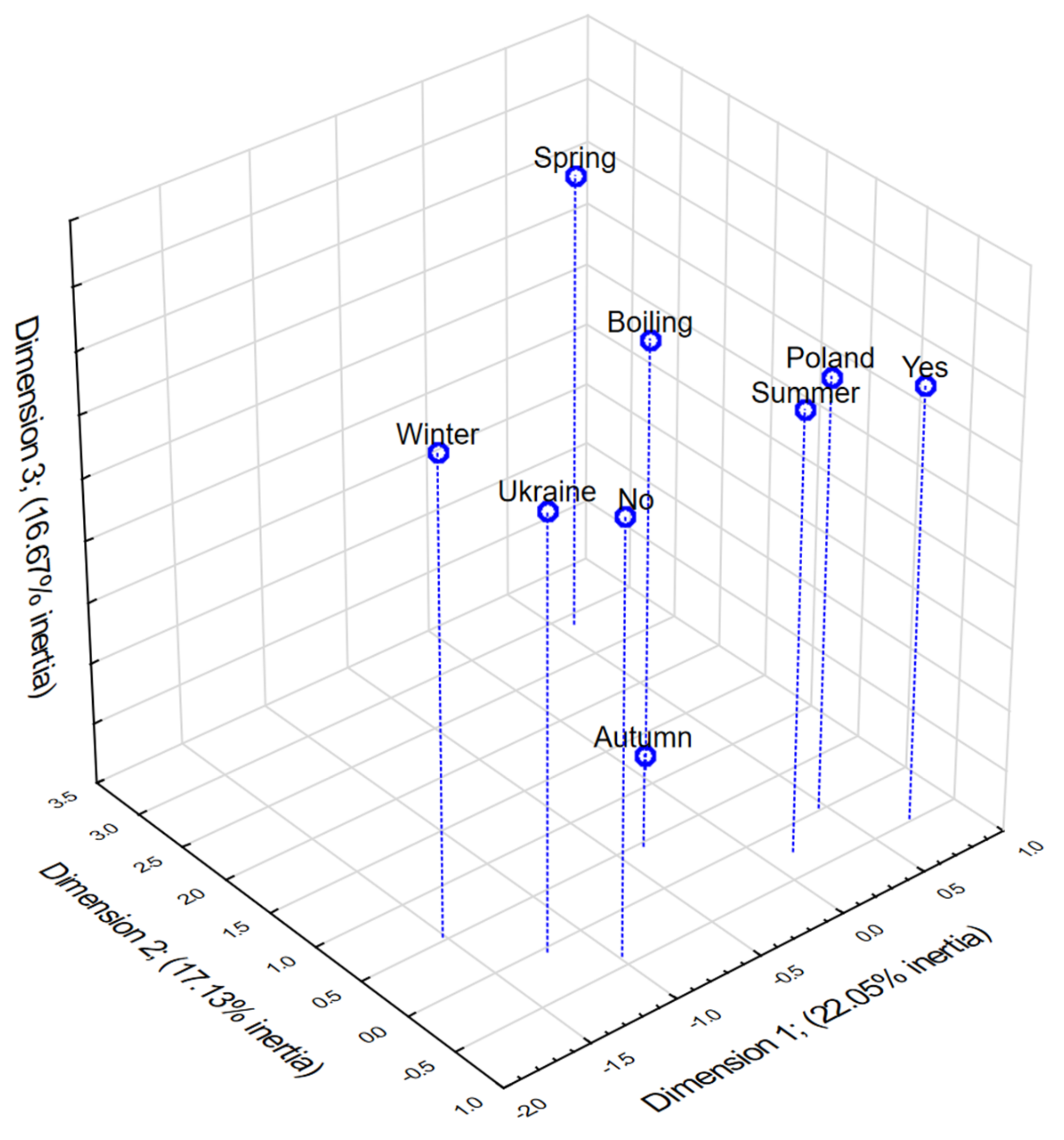
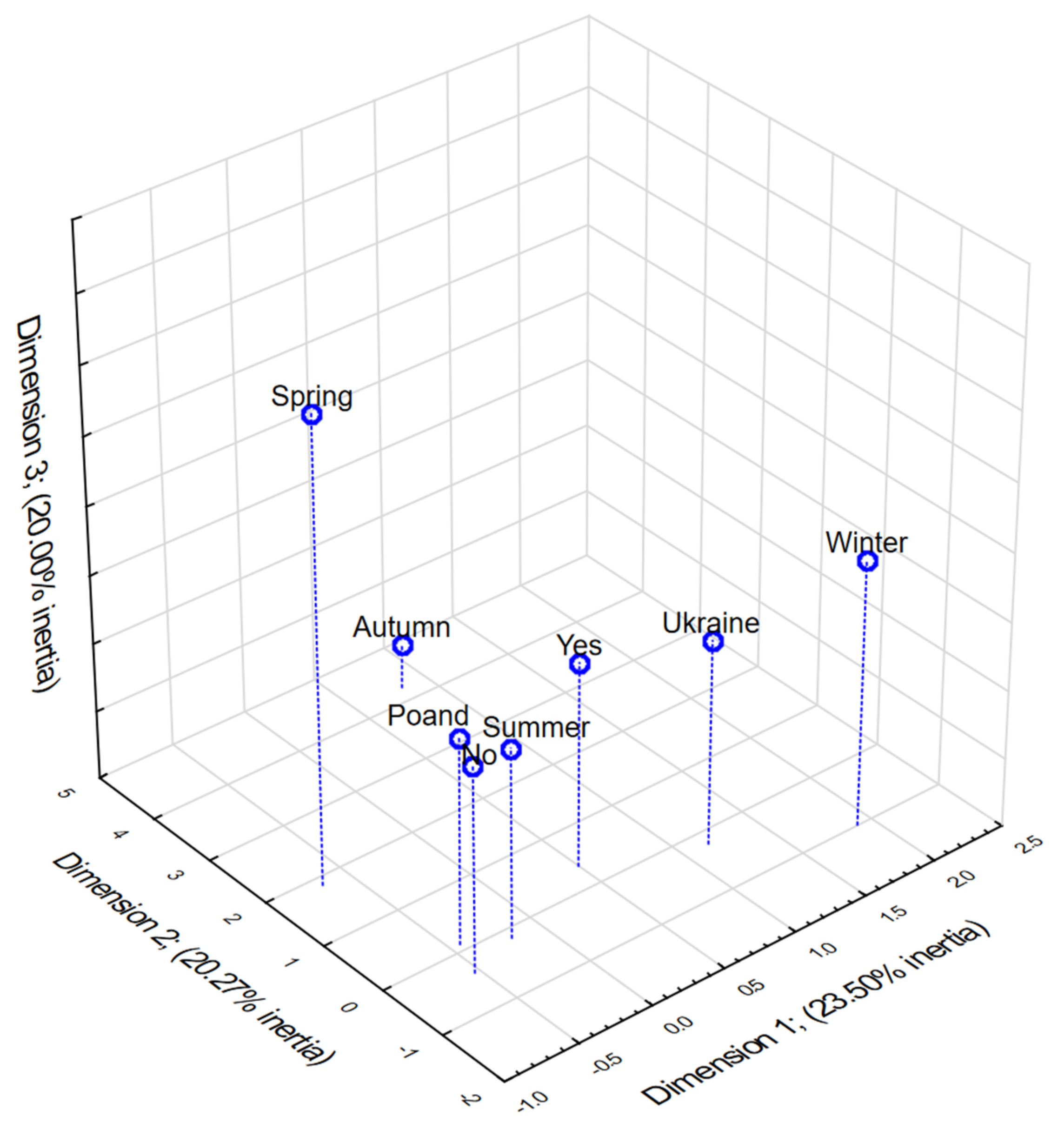

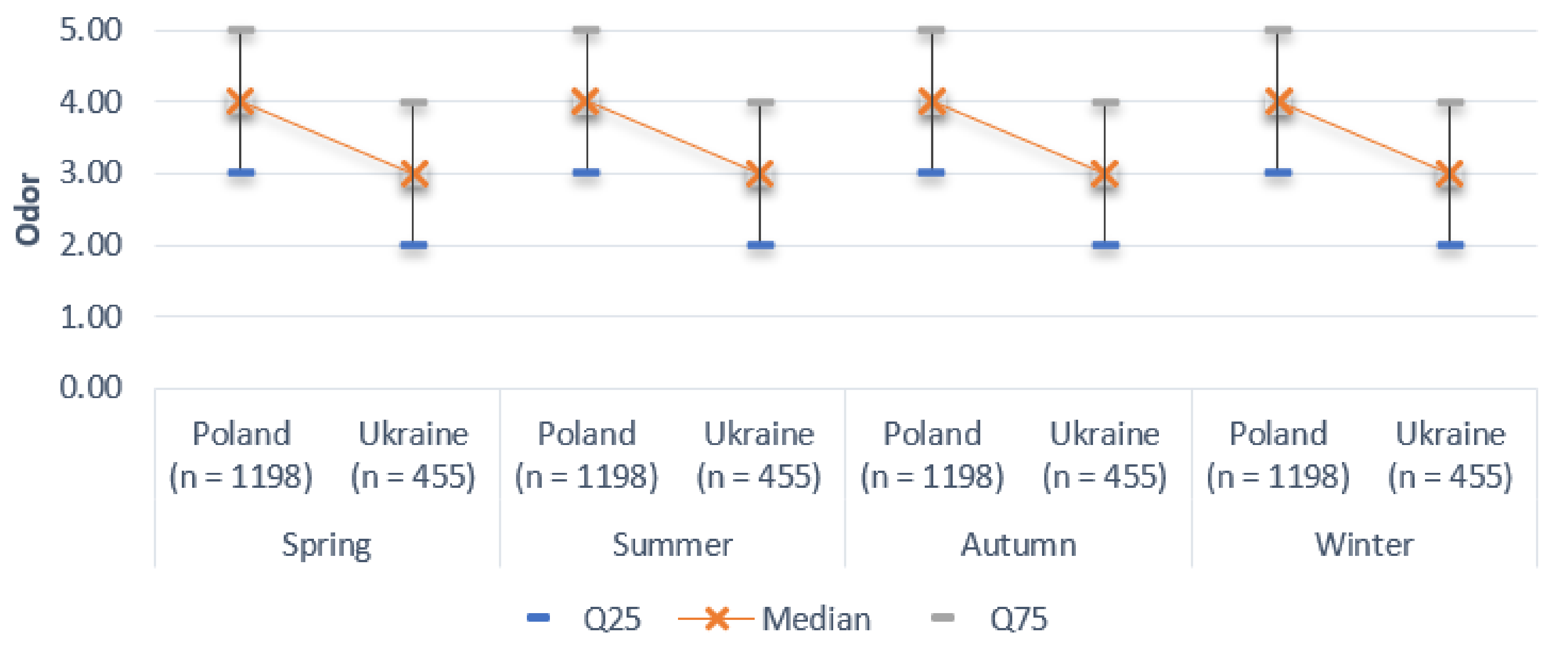
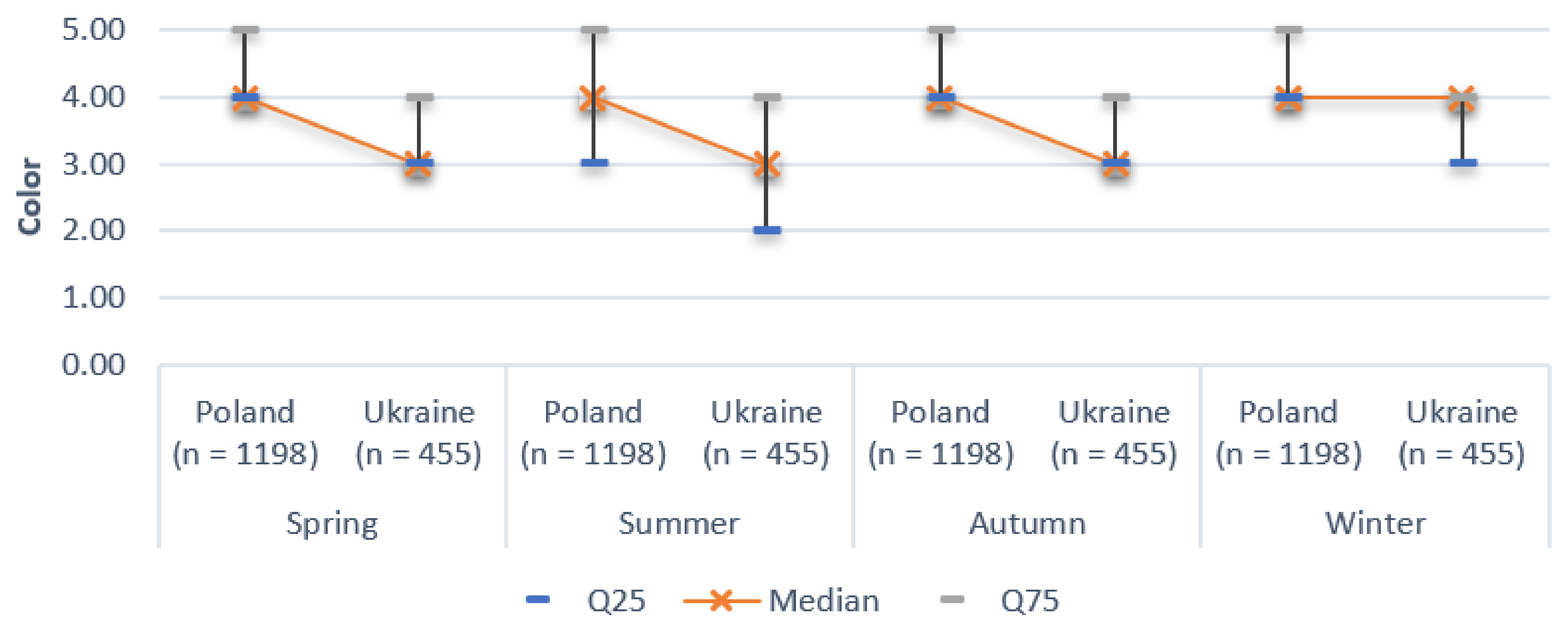
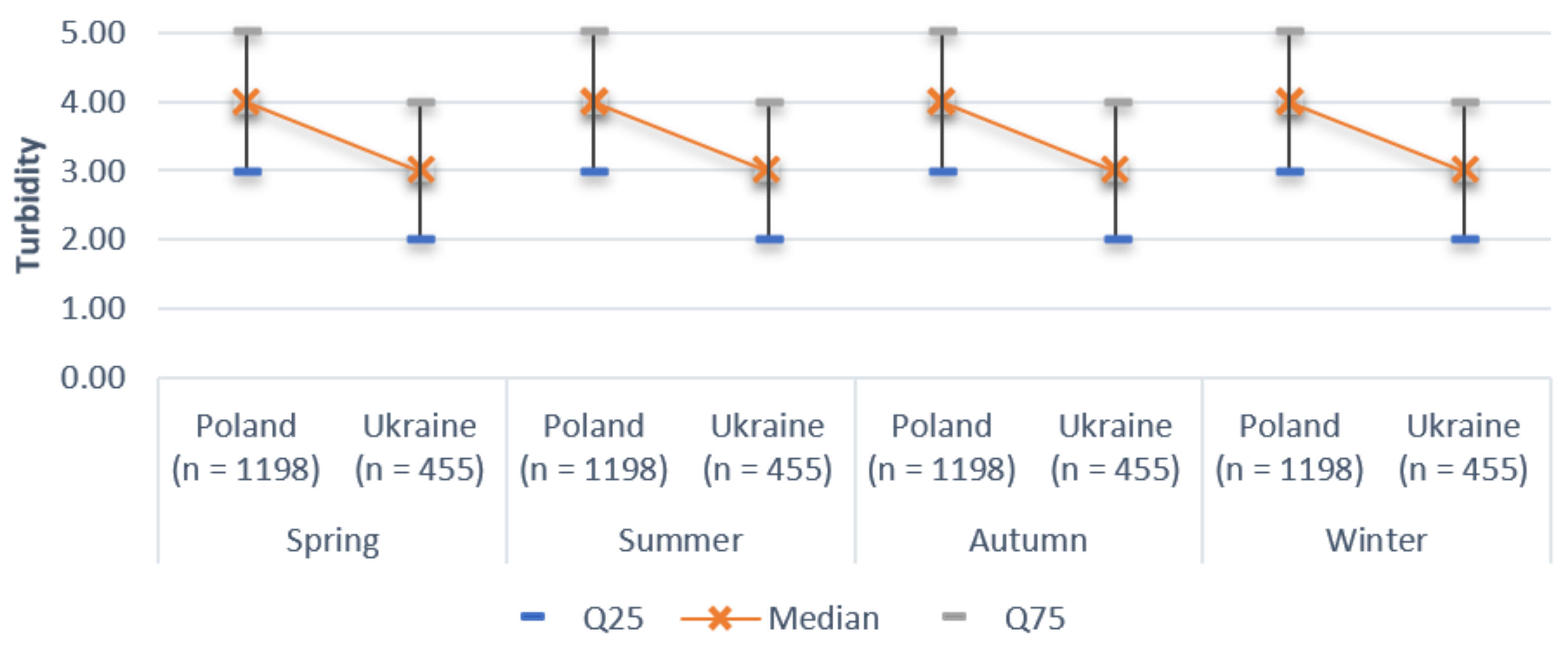
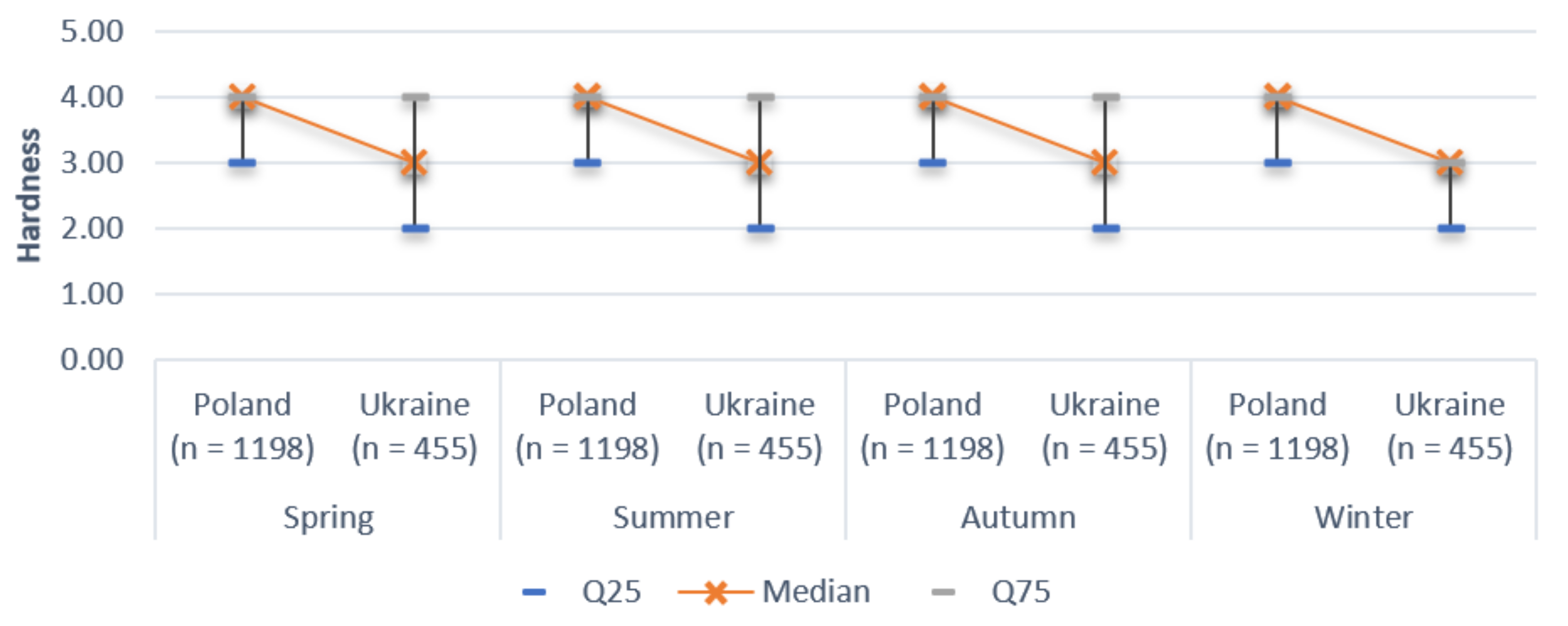

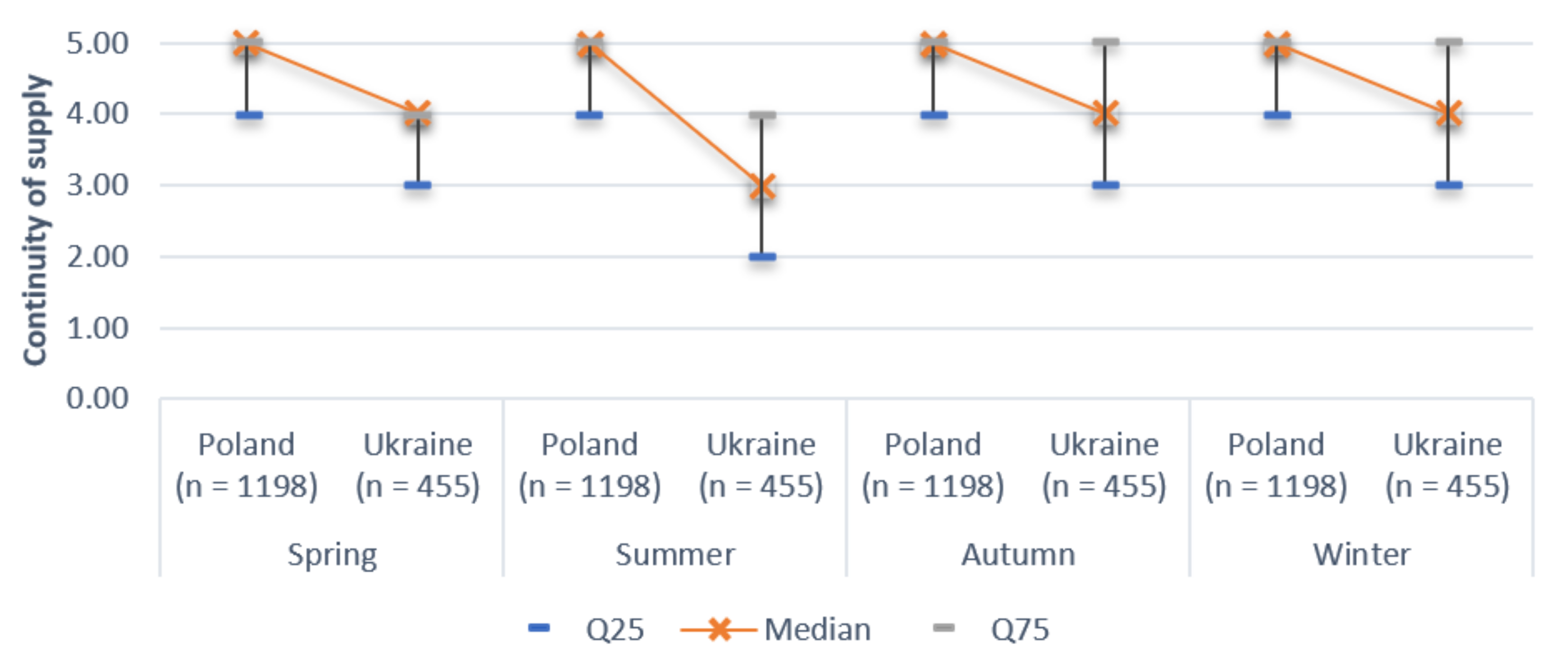
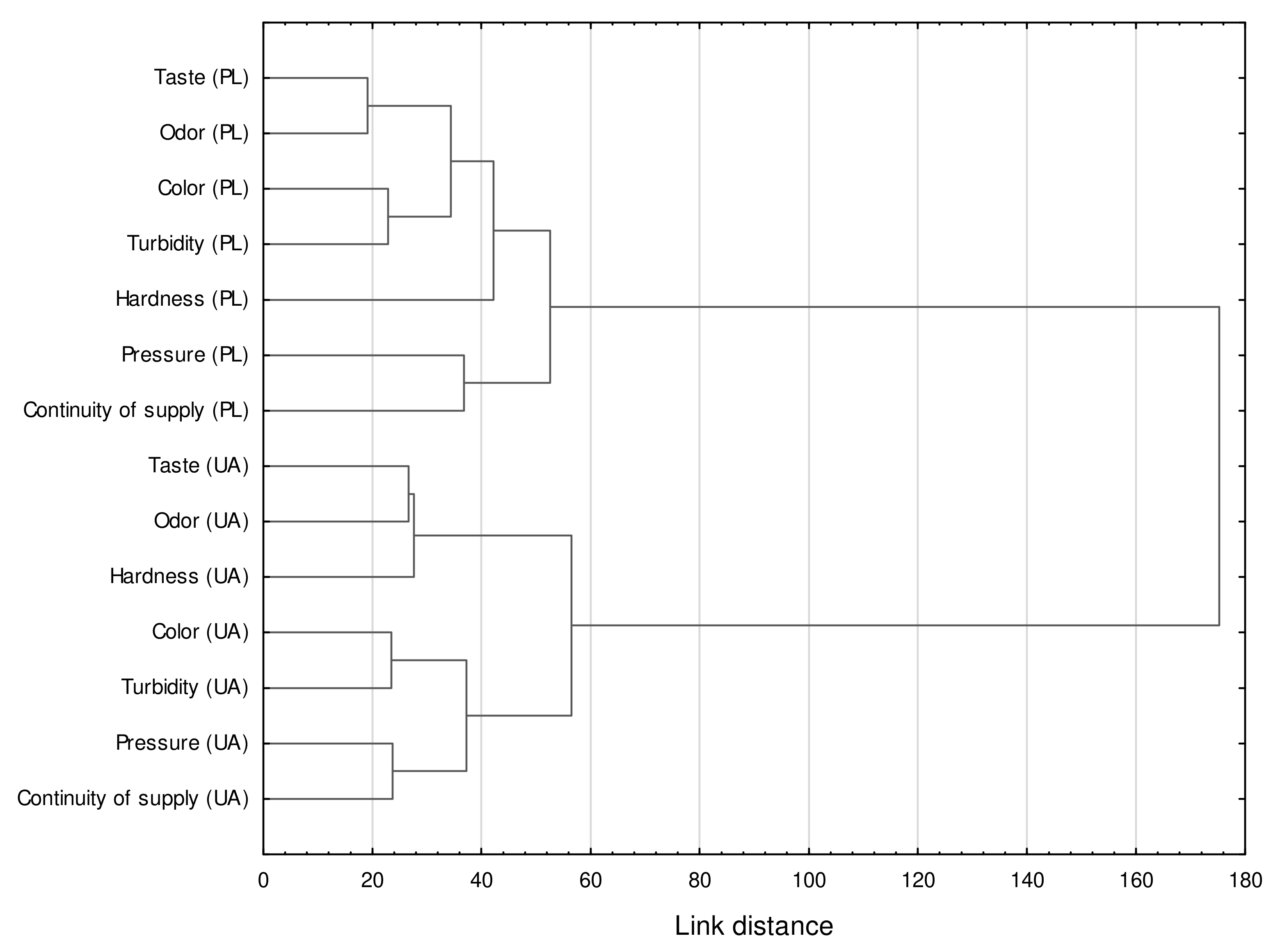
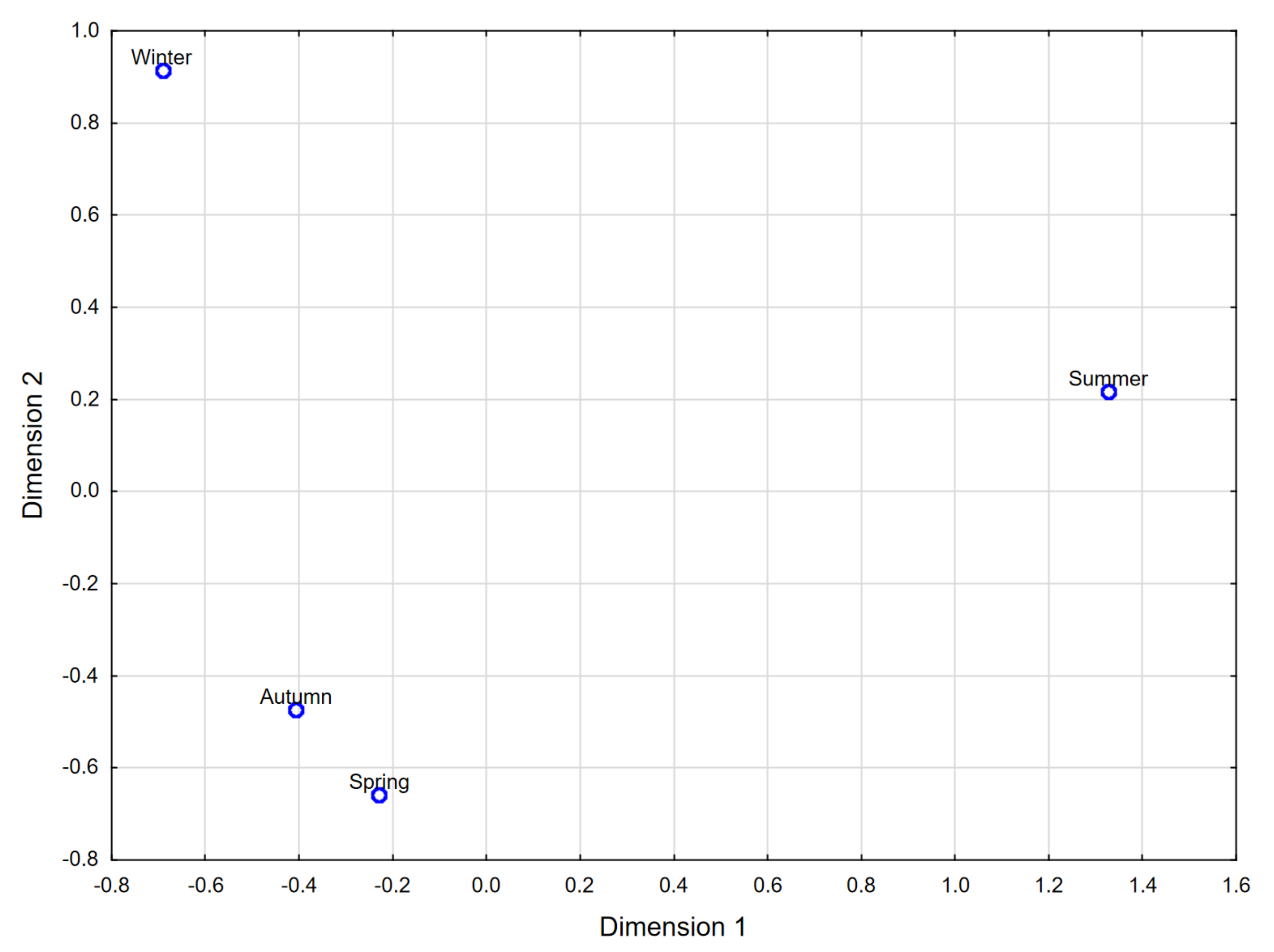
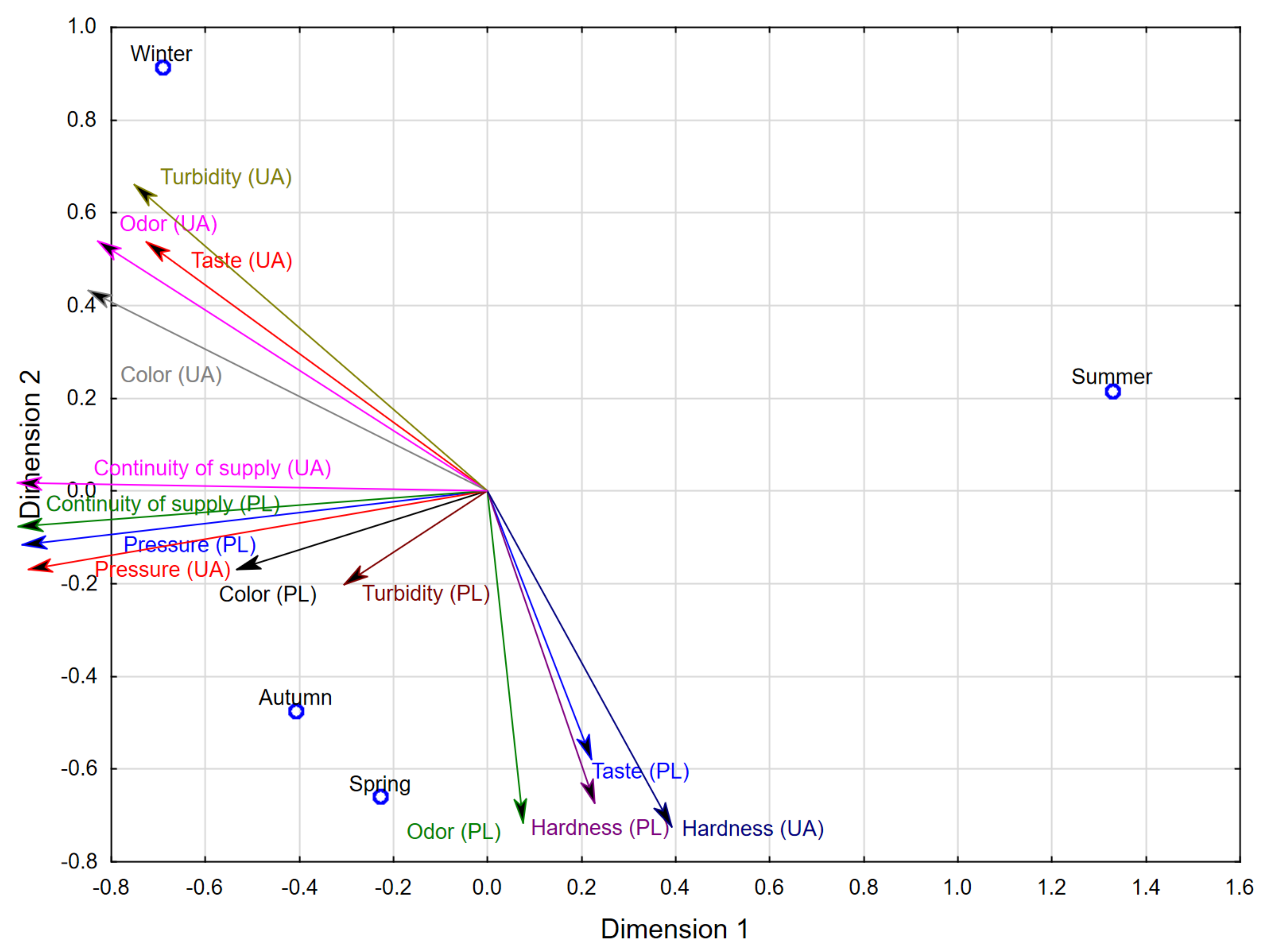
| Chemical Status | |||
|---|---|---|---|
| Good | Below Good | ||
| Ecological status/potential | Very good ecological status | Good water status | Bad water status |
| Good ecological status/ecological potential good or above good | Good water status | Bad water status | |
| Moderate ecological status/moderate ecological potential | Bad water status | Bad water status | |
| Poor ecological status/ecological potential poor | Bad water status | Bad water status | |
| Bad ecological status/ecological potential bad | Bad water status | Bad water status | |
| Water Quality Class | I | II | III | IV | V | ||
|---|---|---|---|---|---|---|---|
| Water Quality Category | 1 | 2 | 3 | 4 | 5 | 6 | 7 |
| Name of class and category of water quality and status | Very good | Good | Satisfactory | Bad | Very bad | ||
| Very good | Very good | Good | Satisfactory | Intermediate | Bad | Very bad | |
| Name of class and category of water quality and its degree of purity (pollution) | Very clean | Clean | Contaminated | Dirty | Very dirty | ||
| Very clean | Clean | Quite clean | Poorly polluted | Moderately polluted | Dirty | Very dirty | |
| Country | Total (n = 1653) | ||||||
|---|---|---|---|---|---|---|---|
| Poland (n = 1198) | Ukraine (n = 455) | ||||||
| n | % | n | % | n | % | ||
| Gender | Men | 628 | 52.42% | 105 | 23.08% | 733 | 44.34% |
| Women | 570 | 47.58% | 350 | 76.92% | 920 | 55.66% | |
| Age | Up to 24 years | 13 | 1.09% | 183 | 40.22% | 196 | 11.86% |
| 25–34 years | 134 | 11.19% | 127 | 27.91% | 261 | 15.79% | |
| 35–44 years | 329 | 27.46% | 84 | 18.46% | 413 | 24.98% | |
| 45–54 years | 316 | 26.38% | 41 | 9.01% | 357 | 21.60% | |
| 55 and over | 406 | 33.89% | 20 | 4.40% | 426 | 25.77% | |
| Education | Primary | 22 | 1.84% | 18 | 3.96% | 40 | 2.42% |
| Secondary | 492 | 41.07% | 79 | 17.36% | 571 | 34.54% | |
| Higher | 684 | 57.10% | 358 | 78.68% | 1042 | 63.04% | |
| Frequencies Observed | ||||||||||
|---|---|---|---|---|---|---|---|---|---|---|
| Input Table (Rows * Columns): 9 × 9 (Burt ‘s Table) | ||||||||||
| Country Poland | Country Ukraine | Spring Period | Summer Period | Autumn Period | Winter Period | Drinking Yes | Drinking Boil. a | Drinking No | Total | |
| Country: Poland | 1198 | 0 | 68 | 1013 | 36 | 81 | 563 | 341 | 294 | 3594 |
| Country: Ukraine | 0 | 455 | 17 | 356 | 16 | 66 | 110 | 123 | 222 | 1365 |
| Period: Spring | 68 | 17 | 85 | 0 | 0 | 0 | 35 | 28 | 22 | 255 |
| Period: Summer | 1013 | 356 | 0 | 1369 | 0 | 0 | 577 | 378 | 414 | 4107 |
| Period: Autumn | 36 | 16 | 0 | 0 | 52 | 0 | 19 | 15 | 18 | 156 |
| Period: Winter | 81 | 66 | 0 | 0 | 0 | 147 | 42 | 43 | 62 | 441 |
| Drinking: Yes | 563 | 110 | 35 | 577 | 19 | 42 | 673 | 0 | 0 | 2019 |
| Drinking: Boil. a | 341 | 123 | 28 | 378 | 15 | 43 | 0 | 464 | 0 | 1392 |
| Drinking: No | 294 | 222 | 22 | 414 | 18 | 62 | 0 | 0 | 516 | 1548 |
| Total | 3594 | 1365 | 255 | 4107 | 156 | 441 | 2019 | 1392 | 1548 | 14,877 |
| Number of Dimensions | Eigenvalues and Inertia (All Dimensions) | ||||
|---|---|---|---|---|---|
| Input Table (Rows * Columns): 9 × 9 (Burt’s Table) | |||||
| Total Inertia = 2.0000 | |||||
| Singular Values | Eigenvalues | Percentage of Inertia | Cumulative Percentage | χ2 | |
| 1 | 0.6641 | 0.4410 | 22.05 | 22.05 | 2250.80 |
| 2 | 0.5854 | 0.3427 | 17.13 | 39.18 | 1749.14 |
| 3 | 0.5774 | 0.3334 | 16.67 | 55.85 | 1701.58 |
| 4 | 0.5696 | 0.3244 | 16.22 | 72.07 | 1655.89 |
| 5 | 0.5571 | 0.3104 | 15.52 | 87.59 | 1584.13 |
| 6 | 0.4982 | 0.2482 | 12.41 | 100.00 | 1266.93 |
| Frequencies Observed | |||||||||
|---|---|---|---|---|---|---|---|---|---|
| Input Table (Rows * Columns): 8 × 8 (Burt’s Table) | |||||||||
| Country Poland | Country Ukraine | Spring Period | Summer Period | Autumn Period | Winter Period | Device Yes | Device No | Total | |
| Country: Poland | 1198 | 0 | 68 | 1013 | 36 | 81 | 597 | 601 | 3594 |
| Country: Ukraine | 0 | 455 | 17 | 356 | 16 | 66 | 273 | 182 | 1365 |
| Period: Spring | 68 | 17 | 85 | 0 | 0 | 0 | 45 | 40 | 255 |
| Period: Summer | 1013 | 356 | 0 | 1369 | 0 | 0 | 708 | 661 | 4107 |
| Period: Autumn | 36 | 16 | 0 | 0 | 52 | 0 | 32 | 20 | 156 |
| Period: Winter | 81 | 66 | 0 | 0 | 0 | 147 | 85 | 62 | 441 |
| Device: Yes | 597 | 273 | 45 | 708 | 32 | 85 | 870 | 0 | 2610 |
| Device: No | 601 | 182 | 40 | 661 | 20 | 62 | 0 | 783 | 2349 |
| Total | 3594 | 1365 | 255 | 4107 | 156 | 441 | 2610 | 2349 | 14,877 |
| Number of Dimensions | Eigenvalues and Inertia (All Dimensions) | ||||
|---|---|---|---|---|---|
| Input Table (Rows * Columns): 8 × 8 (Burt’s Table) | |||||
| Total Inertia = 1.6667 | |||||
| Singular Values | Eigen Values | Percentage of Inertia | Cumulative Percentage | χ2 | |
| 1 | 0.6259 | 0.3917 | 23.50 | 23.50 | 1963.13 |
| 2 | 0.5813 | 0.3379 | 20.27 | 43.78 | 1693.37 |
| 3 | 0.5774 | 0.3333 | 20.00 | 63.78 | 1670.56 |
| 4 | 0.5635 | 0.3176 | 19.05 | 82.83 | 1591.48 |
| 5 | 0.5350 | 0.2862 | 17.17 | 100.00 | 1434.25 |
| Descriptive Statistics—Taste | Mann–Whitney U Test | rg of Glass | |||||||
|---|---|---|---|---|---|---|---|---|---|
| Mean ± Stand Dev. | Median (Q25–Q75) | Min.–Max. | Confidence Interval | Stand. Error | |||||
| –95.00% | +95.00% | ||||||||
| Spring | Poland (n = 1198) | 3.83 ± 1.01 | 4 (3–5) | 1–5 | 3.77 | 3.89 | 0.03 | Z = 17.57; p < 0.001 | 0.56 |
| Ukraine n = 455) | 2.56 ± 1.22 | 3 (1–3) | 1–5 | 2.45 | 2.67 | 0.06 | |||
| Summer | Poland (n = 1198) | 3.8 ± 1.03 | 4 (3–5) | 1–5 | 3.74 | 3.86 | 0.03 | Z = 16.72; p < 0.001 | 0.53 |
| Ukraine (n = 455) | 2.56 ± 1.27 | 3 (1–3) | 1–5 | 2.44 | 2.68 | 0.06 | |||
| Autumn | Poland (n = 1198) | 3.78 ± 1.04 | 4 (3–5) | 1–5 | 3.72 | 3.84 | 0.03 | Z = 16.31; p < 0.001 | 0.52 |
| Ukraine (n = 455) | 2.62 ± 1.21 | 3 (1–4) | 1–5 | 2.50 | 2.73 | 0.06 | |||
| Winter | Poland (n = 1198) | 3.78 ± 1.11 | 4 (3–5) | 1–5 | 3.72 | 3.84 | 0.03 | Z = 15.25; p < 0.001 | 0.48 |
| Ukraine (n = 455) | 2.64 ± 1.28 | 3 (1–4) | 1–5 | 2.52 | 2.76 | 0.06 | |||
| Descriptive Statistics—Odor | Mann–Whitney U Test | rg of Glass | |||||||
|---|---|---|---|---|---|---|---|---|---|
| Mean ± Stand. Dev. | Median (Q25–Q75) | Min.–Max. | Confidence Interval | Stand. Error | |||||
| –95.00% | +95.00% | ||||||||
| Spring | Poland (n = 1198) | 3.89 ± 1.02 | 4 (3–5) | 1–5 | 3.83 | 3.94 | 0.03 | Z = 13.82; p < 0.001 | 0.44 |
| Ukraine (n = 455) | 2.98 ± 1.17 | 3 (2–4) | 1–5 | 2.87 | 3.09 | 0.05 | |||
| Summer | Poland (n = 1198) | 3.85 ± 1.04 | 4 (3–5) | 1–5 | 3.79 | 3.91 | 0.03 | Z = 13.78; p < 0.001 | 0.44 |
| Ukraine (n = 455) | 2.95 ± 1.16 | 3 (2–4) | 1–5 | 2.84 | 3.05 | 0.05 | |||
| Autumn | Poland (n = 1198) | 3.85 ± 1.05 | 4 (3–5) | 1–5 | 3.79 | 3.91 | 0.03 | Z = 13.21; p < 0.001 | 0.42 |
| Ukraine (n = 455) | 3.02 ± 1.11 | 3 (2–4) | 1–5 | 2.91 | 3.12 | 0.05 | |||
| Winter | Poland (n = 1198) | 3.84 ± 1.12 | 4 (3–5) | 1–5 | 3.77 | 3.90 | 0.03 | Z = 11.79; p < 0.001 | 0.38 |
| Ukraine (n = 455) | 3.08 ± 1.17 | 3 (2–4) | 1–5 | 2.97 | 3.18 | 0.05 | |||
| Descriptive Statistics—Color | Mann–Whitney U Test | rg of Glass | |||||||
|---|---|---|---|---|---|---|---|---|---|
| Mean ± Stand. Dev. | Median (Q25–Q75) | Min.–Max. | Confidence Interval | Stand. Error | |||||
| –95.00% | +95.00% | ||||||||
| Spring | Poland (n = 1198) | 4.05 ± 1.04 | 4 (4–5) | 1–5 | 3.99 | 4.11 | 0.03 | Z = 11.48; p < 0.001 | 0.36 |
| Ukraine (n = 455) | 3.31 ± 1.2 | 3 (3–4) | 1–5 | 3.19 | 3.42 | 0.06 | |||
| Summer | Poland (n = 1198) | 4.01 ± 1.07 | 4 (3–5) | 1–5 | 3.95 | 4.07 | 0.03 | Z = 11.89; p < 0.001 | 0.38 |
| Ukraine (n = 455) | 3.2 ± 1.25 | 3 (2–4) | 1–5 | 3.08 | 3.31 | 0.06 | |||
| Autumn | Poland (n = 1198) | 4.01 ± 1.07 | 4 (4–5) | 1–5 | 3.95 | 4.07 | 0.03 | Z = 11.56; p < 0.001 | 0.37 |
| Ukraine (n = 455) | 3.27 ± 1.19 | 3 (3–4) | 1–5 | 3.16 | 3.38 | 0.06 | |||
| Winter | Poland (n = 1198) | 4.03 ± 1.08 | 4 (4–5) | 1–5 | 3.97 | 4.10 | 0.03 | Z = 10.08; p < 0.001 | 0.32 |
| Ukraine (n = 455) | 3.4 ± 1.19 | 4 (3–4) | 1–5 | 3.29 | 3.51 | 0.06 | |||
| Descriptive Statistics—Turbidity | Mann–Whitney U Test | rg of Glass | |||||||
|---|---|---|---|---|---|---|---|---|---|
| Mean ± Stand. Dev. | Median (Q25–Q75) | Min.–Max. | Confidence Interval | Stand. Error | |||||
| –95.00% | +95.00% | ||||||||
| Spring | Poland (n = 1198) | 3.96 ± 1.06 | 4 (3–5) | 1–5 | 3.90 | 4.02 | 0.03 | Z = 12.91; p < 0.001 | 0.41 |
| Ukraine (n = 455) | 3.13 ± 1.15 | 3 (2–4) | 1–5 | 3.02 | 3.23 | 0.05 | |||
| Summer | Poland (n = 1198) | 3.94 ± 1.08 | 4 (3–5) | 1–5 | 3.88 | 4.01 | 0.03 | Z = 12.71; p < 0.001 | 0.40 |
| Ukraine (n = 455) | 3.11 ± 1.17 | 3 (2–4) | 1–5 | 3.00 | 3.22 | 0.06 | |||
| Autumn | Poland (n = 1198) | 3.94 ± 1.07 | 4 (3–5) | 1–5 | 3.88 | 4.00 | 0.03 | Z = 12.64; p < 0.001 | 0.40 |
| Ukraine (n = 455) | 3.14 ± 1.13 | 3 (2–4) | 1–5 | 3.04 | 3.25 | 0.05 | |||
| Winter | Poland (n = 1198) | 3.95 ± 1.09 | 4 (3–5) | 1–5 | 3.89 | 4.01 | 0.03 | Z = 11.75; p < 0.001 | 0.37 |
| Ukraine (n = 455) | 3.19 ± 1.18 | 3 (2–4) | 1–5 | 3.08 | 3.30 | 0.06 | |||
| Descriptive Statistics—Hardness | Mann–Whitney U Test | rg pf Glass | |||||||
|---|---|---|---|---|---|---|---|---|---|
| Mean ± Stand. Dev. | Median (Q25–Q75) | Min.–Max. | Confidence Interval | Stand. Error | |||||
| –95.00% | +95.00% | ||||||||
| Spring | Poland (n = 1198) | 3.54 ± 1.14 | 4 (3–4) | 1–5 | 3.47 | 3.60 | 0.03 | Z = 11.62; p < 0.001 | 0.37 |
| Ukraine (n = 455) | 2.77 ± 1.13 | 3 (2–4) | 1–5 | 2.66 | 2.87 | 0.05 | |||
| Summer | Poland (n = 1198) | 3.52 ± 1.15 | 4 (3–4) | 1–5 | 3.46 | 3.59 | 0.03 | Z = 11.24; p < 0.001 | 0.36 |
| Ukraine (n = 455) | 2.78 ± 1.13 | 3 (2–4) | 1–5 | 2.67 | 2.88 | 0.05 | |||
| Autumn | Poland (n = 1198) | 3.52 ± 1.15 | 4 (3–4) | 1–5 | 3.45 | 3.58 | 0.03 | Z = 11.05; p < 0.001 | 0.35 |
| Ukraine (n = 455) | 2.79 ± 1.11 | 3 (2–4) | 1–5 | 2.68 | 2.89 | 0.05 | |||
| Winter | Poland (n = 1198) | 3.51 ± 1.17 | 4 (3–4) | 1–5 | 3.44 | 3.58 | 0.03 | Z = 11.46; p < 0.001 | 0.36 |
| Ukraine (n = 455) | 2.75 ± 1.13 | 3 (2–3) | 1–5 | 2.64 | 2.85 | 0.05 | |||
| Descriptive Statistics—Pressure | Mann–Whitney U Test | rg of Glass | |||||||
|---|---|---|---|---|---|---|---|---|---|
| Mean ± Stand. Dev. | Median (Q25–Q75) | Min.–Max. | Confidence Interval | Stand. Error | |||||
| –95.00% | +95.00% | ||||||||
| Spring | Poland (n = 1198) | 3.97 ± 1.1 | 4 (3–5) | 1–5 | 3.91 | 4.03 | 0.03 | Z = 7.2; p < 0.001 | 0.23 |
| Ukraine (n = 455) | 3.6 ± 1.03 | 4 (3–4) | 1–5 | 3.50 | 3.69 | 0.05 | |||
| Summer | Poland (n = 1198) | 3.68 ± 1.19 | 4 (3–5) | 1–5 | 3.61 | 3.74 | 0.03 | Z = 4.95; p < 0.001 | 0.16 |
| Ukraine (n = 455) | 3.39 ± 1.11 | 3 (3–4) | 1–5 | 3.29 | 3.49 | 0.05 | |||
| Autumn | Poland (n = 1198) | 3.96 ± 1.11 | 4 (3–5) | 1–5 | 3.90 | 4.02 | 0.03 | Z = 7.27; p < 0.001 | 0.23 |
| Ukraine (n = 455) | 3.58 ± 1.04 | 4 (3–4) | 1–5 | 3.48 | 3.67 | 0.05 | |||
| Winter | Poland (n = 1198) | 3.99 ± 1.11 | 4 (3–5) | 1–5 | 3.93 | 4.06 | 0.03 | Z = 7.26; p < 0.001 | 0.23 |
| Ukraine (n = 455) | 3.6 ± 1.08 | 4 (3–4) | 1–5 | 3.50 | 3.69 | 0.05 | |||
| Descriptive Statistics—Continuity of Supply | Mann–Whitney U Test | rg of Glass | |||||||
|---|---|---|---|---|---|---|---|---|---|
| Mean ± Stand. Dev. | Median (Q25–Q75) | Min.–Max. | Confidence Interval | Stand. Error | |||||
| –95.00% | +95.00% | ||||||||
| Spring | Poland (n = 1198) | 4.53 ± 0.78 | 5 (4–5) | 1–5 | 4.49 | 4.58 | 0.02 | Z = 15.88; p < 0.001 | 0.51 |
| Ukraine (n = 455) | 3.52 ± 1.2 | 4 (3–4) | 1–5 | 3.41 | 3.63 | 0.06 | |||
| Summer | Poland (n = 1198) | 4.48 ± 0.81 | 5 (4–5) | 1–5 | 4.44 | 4.53 | 0.02 | Z = 18.27; p < 0.001 | 0.58 |
| Ukraine (n = 455) | 3.08 ± 1.39 | 3 (2–4) | 1–5 | 2.95 | 3.20 | 0.06 | |||
| Autumn | Poland (n = 1198) | 4.54 ± 0.78 | 5 (4–5) | 1–5 | 4.50 | 4.58 | 0.02 | Z = 15.38; p < 0.001 | 0.49 |
| Ukraine (n = 455) | 3.61 ± 1.15 | 4 (3–5) | 1–5 | 3.50 | 3.71 | 0.05 | |||
| Winter | Poland (n = 1198) | 4.54 ± 0.78 | 5 (4–5) | 1–5 | 4.50 | 4.59 | 0.02 | Z = 13.98; p < 0.001 | 0.44 |
| Ukraine (n = 455) | 3.68 ± 1.18 | 4 (3–5) | 1–5 | 3.57 | 3.79 | 0.06 | |||
| Elements of Individual Clusters | Distance | Descriptive Statistics—Spring | ||||||
|---|---|---|---|---|---|---|---|---|
| Mean ± Stand. Dev. | Median (Q25–Q75) | Min.–Max. | Confidence Interval | Stand. Error | ||||
| –95.00% | +95.00% | |||||||
| Cluster 1 | Taste (PL) | 0.5171 | 3.97 ± 1.06 | 4 (3–5) | 1–5 | 3.94 | 3.99 | 0.01 |
| Odor (PL) | 0.5228 | |||||||
| Color (PL) | 0.5311 | |||||||
| Turbidity (PL) | 0.5458 | |||||||
| Hardness (PL) | 0.8380 | |||||||
| Pressure (PL) | 0.7907 | |||||||
| Continuity of supply (PL) | 0.8249 | |||||||
| Cluster 2 | Taste (UA) | 0.6512 | 3.12 ± 1.21 | 3 (2–4) | 1–5 | 3.08 | 3.16 | 0.02 |
| Odor (UA) | 0.5088 | |||||||
| Color (UA) | 0.4846 | |||||||
| Turbidity (UA) | 0.4964 | |||||||
| Hardness (UA) | 0.5426 | |||||||
| Pressure (UA) | 0.5844 | |||||||
| Continuity of supply (UA) | 0.6406 | |||||||
| Spring | Summer | Autumn | Winter | |
|---|---|---|---|---|
| Taste (PL) | 3.83 | 3.80 | 3.78 | 3.78 |
| Taste (UA) | 2.56 | 2.56 | 2.62 | 2.64 |
| Odor (PL) | 3.89 | 3.85 | 3.85 | 3.84 |
| Odor(UA) | 2.98 | 2.95 | 3.02 | 3.08 |
| Color (PL) | 4.05 | 4.01 | 4.01 | 4.03 |
| Color (UA) | 3.31 | 3.20 | 3.27 | 3.40 |
| Turbidity (PL) | 3.96 | 3.94 | 3.94 | 3.95 |
| Turbidity (UA) | 3.13 | 3.11 | 3.14 | 3.19 |
| Hardness (PL) | 3.54 | 3.52 | 3.52 | 3.51 |
| Hardness (UA) | 2.77 | 2.78 | 2.79 | 2.75 |
| Pressure (PL) | 3.97 | 3.68 | 3.96 | 3.99 |
| Pressure (UA) | 3.60 | 3.39 | 3.58 | 3.60 |
| Continuity of supply (PL) | 4.53 | 4.48 | 4.54 | 4.54 |
| Continuity of supply (UA) | 3.52 | 3.08 | 3.61 | 3.68 |
| Absolute Term | DIM.1 | DIM.2 | R2 | ||||
|---|---|---|---|---|---|---|---|
| b0 | p | b | p | b | p | ||
| Taste (PL) | 3.796 | p < 0.01 | 0.006 | p = 0.825 | –0.019 | p = 0.596 | 0.3829 |
| Taste (UA) | 2.594 | p < 0.01 | –0.033 | p = 0.341 | 0.031 | p = 0.43 | 0.8144 |
| Odor (PL) | 3.856 | p < 0.01 | 0.002 | p = 0.931 | –0.021 | p = 0.49 | 0.5185 |
| Odor (UA) | 3.004 | p < 0.01 | –0.052 | p = 0.112 | 0.043 | p = 0.17 | 0.9782 |
| Color (PL) | 4.027 | p < 0.01 | –0.012 | p = 0.636 | –0.005 | p = 0.872 | 0.3127 |
| Color (UA) | 3.292 | p < 0.01 | –0.077 | p = 0.217 | 0.050 | p = 0.387 | 0.9091 |
| Turbidity (PL) | 3.949 | p < 0.01 | –0.003 | p = 0.798 | –0.002 | p = 0.865 | 0.1338 |
| Turbidity (UA) | 3.143 | p < 0.001 | –0.028 | p < 0.05 | 0.032 | p < 0.05 | 0.9992 |
| Hardness (PL) | 3.522 | p < 0.01 | 0.003 | p = 0.801 | –0.011 | p = 0.514 | 0.5054 |
| Hardness (UA) | 2.769 | p < 0.01 | 0.008 | p = 0.616 | –0.018 | p = 0.424 | 0.6767 |
| Pressure (PL) | 3.899 | p < 0.01 | –0.163 | p < 0.063 | –0.024 | p = 0.447 | 0.9904 |
| Pressure (UA) | 3.540 | p < 0.01 | –0.109 | p < 0.086 | –0.024 | p = 0.424 | 0.9823 |
| Continuity of supply (PL) | 4.525 | p < 0.001 | –0.031 | p < 0.01 | –0.003 | p = 0.1 | 0.9999 |
| Continuity of supply (UA) | 3.473 | p < 0.01 | –0.300 | p < 0.05 | 0.007 | p = 0.781 | 0.9975 |
Publisher’s Note: MDPI stays neutral with regard to jurisdictional claims in published maps and institutional affiliations. |
© 2022 by the authors. Licensee MDPI, Basel, Switzerland. This article is an open access article distributed under the terms and conditions of the Creative Commons Attribution (CC BY) license (https://creativecommons.org/licenses/by/4.0/).
Share and Cite
Ober, J.; Karwot, J.; Rusakov, S. Tap Water Quality and Habits of Its Use: A Comparative Analysis in Poland and Ukraine. Energies 2022, 15, 981. https://doi.org/10.3390/en15030981
Ober J, Karwot J, Rusakov S. Tap Water Quality and Habits of Its Use: A Comparative Analysis in Poland and Ukraine. Energies. 2022; 15(3):981. https://doi.org/10.3390/en15030981
Chicago/Turabian StyleOber, Józef, Janusz Karwot, and Serhii Rusakov. 2022. "Tap Water Quality and Habits of Its Use: A Comparative Analysis in Poland and Ukraine" Energies 15, no. 3: 981. https://doi.org/10.3390/en15030981
APA StyleOber, J., Karwot, J., & Rusakov, S. (2022). Tap Water Quality and Habits of Its Use: A Comparative Analysis in Poland and Ukraine. Energies, 15(3), 981. https://doi.org/10.3390/en15030981








